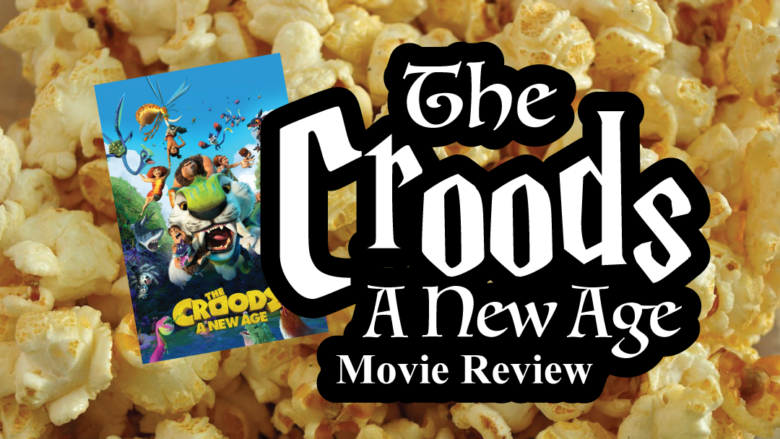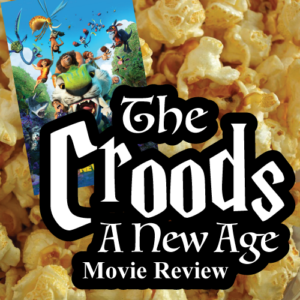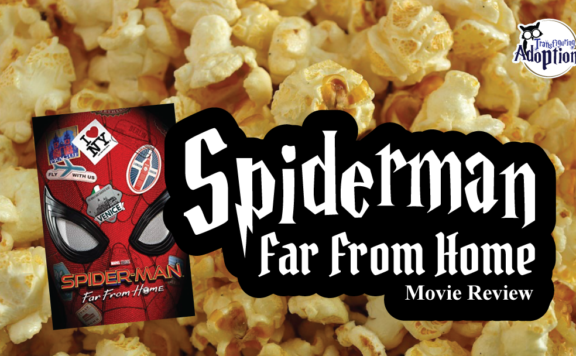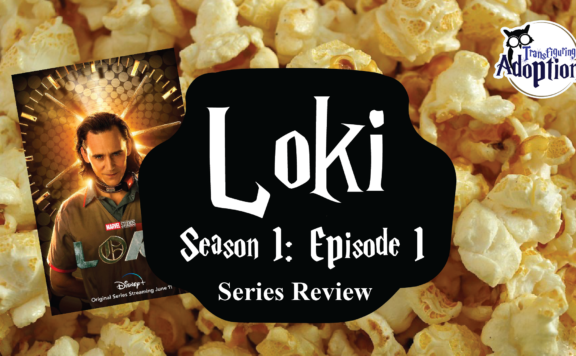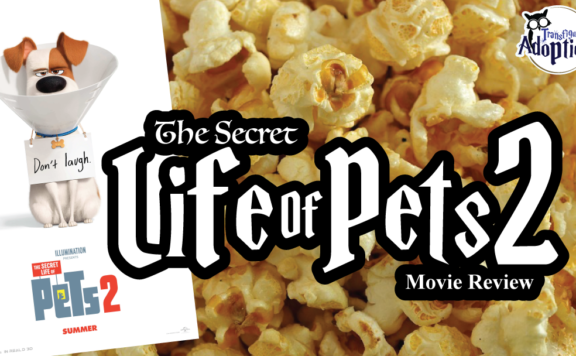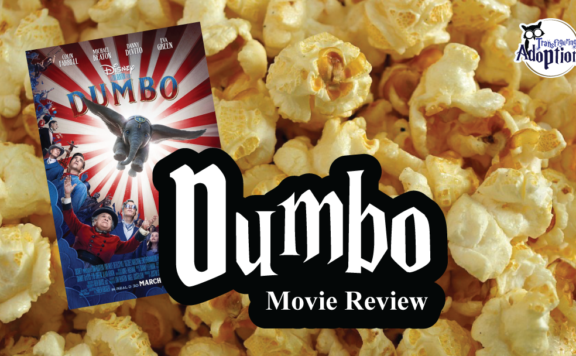Grade:
Transfiguring Adoption awarded this movie 3 Hoots out of 5 based on how useful it will be for a foster/adoptive family. [Learn more about our Hoot grading system here]
Movie Info:
- Rating: PG – Peril, Action, Rude Humor.
- Genre: Comedy, Adventure, Animation, Kids & Family
- Runtime: 95 minutes
- Studio: DreamWorks Animation
From the Cover of The Croods: A New Age by DreamWorks Animation:
“Searching for a safer habitat, the prehistoric Crood family discovers an idyllic, walled-in paradise that meets all of its needs. Unfortunately, they must also learn to live with the Bettermans—a family a couple of steps above the Croods on the evolutionary ladder. As tensions between the new neighbors start to rise, a new threat soon propels both clans on an epic adventure that forces them to embrace their differences, draw strength from one another, and survive together.”
Transfiguring Adoption’s Overview:
The target audience appears to be children age 9 and up. It also appears this movie would be best for most families with a caregiver nearby. While this movie does not directly address foster care it does address the feelings Guy has experienced as a child orphaned and trying to connect his past identity to his present. This is something foster and adoptive children may identify with while integrating experiences from a biological family and a found family.
** Spoilers Could Be Ahead **
How Is This Relevant To Adoption & Foster Care?
In this sequel to The Croods (2013), The focus shifts to the pack newcomer, Guy. Guy is introduced to this film with a backstory explaining how he came to find the Croods prior to the events of the first film. In this sequence we discover that Guy suffered intense trauma in watching his parents sink into tar (leading to their deaths) and having to navigate the world alone while searching for “Tomorrow”. While traveling with the Croods in the present the pack stumbles upon an oasis of sorts created by close friends of Guy’s family, the Bettermans. While Guy is excited to reunite with old friends and openness to innovations he realizes very quickly that his “Tomorrow” has changed since meeting the Croods (especially Eep) and that combining the past and present isn’t as easy as he expected with cultural differences and strong emotions involved. Foster and adoptive families can watch this movie to gain a better understanding of the internal struggle foster and adoptive children may be experiencing integrating all of their past and present together and children may relate to Guy’s struggle as well as Eep and the Crood’s struggles to fit in with the Bettermans.
Discussion Points:
- Cultural Diversity
Though the Croods and Bettermans are both human they have intense cultural differences in communication and how they live. This does not mean that one culture is better than the other, just that each family has learned unique ways to survive in the new age. In the same way, children that have come to your home from another household will also have lots of differences in how they may try to communicate with you and clash with some differences. Looking at the journey the Croods and Bettermans take in learning to appreciate the unique aspects of each family can be a wonderful example to caregiver and child alike as to how to blend a family and show appreciation for what different cultures can teach us. - Integrating Our Past and Present
While Guy appears to be a go-with-the-flow dude he has certainly endured some traumatic events prior to meeting the Croods. The start of the film gives the audience a brief summary of how Guy came to find the Croods complete with watching his parents sink into a deadly tar pit, being alone in the dark to navigate “tomorrow”, finding belt, and using creative inventions to help him survive. Though Guy now has spent a significant amount of time with the Croods, he still finds himself out of place due to his experiences growing up. Upon reuniting with the Bettermans, Guy significantly struggles with integrating his past with his present for a clear future with Eep. Children from the child welfare system often experience the same struggle. They have one foot in the identity of their family of origin or culture and another foot in their current circumstances of navigating their place in their new family, whether temporarily or permanently. Watching Guy’s struggle to pick and eventually bring together all parts of his identity to forge a future with Eep can be a wonderful depiction to help give a child vocabulary to express feelings of this nature and give hope to finding a “tomorrow” for themselves. - Emotional Scars Hit Deeper than Physical Scars
This point comes up while Eep and Dawn discuss scars as well as while Phil and Grug start slinging emotional punches in the ring surrounded by screaming Punch Monkeys. Throughout the film there is a consistent theme of how some scars are not so visible but can leave a lasting impact on someone. Like Eep, some children may wear some scars on their sleeve and be willing to share these experiences quickly. For kids like the Bettermans some may prefer to hide these scars behind passive aggression, snarkiness, and defiance. This is a great metaphor to talk to children about their own scars in a safe way as many children struggle to connect their feelings or experiences to behavior, especially if it happened a long time ago or before your child developed a visual memory.
Cautionary Points:
- A Lot of Violence
This film is about cavepersons so the weapons are more primitive, but there is still a lot of violence in this film. Most of the violence are used in slap-stick humor bits (i.e. – a repeated eye stabbing bit, siblings fighting and threatening groin shots, etc.) but there are intense sequences where the families battle monsters or creatures that mean them harm and several characters are in peril. While most children will laugh at these sequences or not be bothered children who have endured trauma from physical abuse or witnessing domestic violence may struggle with some of the more intense scenes. In addition to this, the Punch Monkeys’ language is based on violent acts like punching, kicking, biting, headbutting, etc. and this is made the be a funny joke. The characters show that they are visibly hurt by this communication style but caregivers should be aware as to prevent their children or youth from mimicking such bits with their peers. - Unrealistic Stunt Sequences Without Consequences
Though most of these stunts are done for comedic value there are several stunts involving riding/wrecking animals as if they are cars, jumping off of extreme heights, and other stunts that should not be mimicked by children or youth. Children or youth who have lacked supervision and care may attempt to mimic such stunts seeing that there are no long-term ramifications for the characters. - Censored Cursing
There are several sequences of characters cursing where either another character or nature (i.e. – geyser) may interrupt or censor the character cursing. These characters are all adults who engage in the censored language but children who have endured trauma may be better able to fill in the blanks than others and may attempt to mimic these scenes as well. - Characters Shown Under Influence of Substances
During the film Dawn is stung by a bee and in this universe these bee stings cause the characters to act as if they were drunk with slurred speech, inappropriate laughter, stumbling, and saying strange things. In the end credits this is brought up again during a banana party (complete with Grug doing a keg stand and the characters playing a sort of beer-pong game) while Dawn and her mom are shown laughing with stung hands as if they were stung on purpose for the drunkenness-effect. Though this will fly over many children’s heads, many children and youth who have endured trauma have witnessed such behavior in the past and this may trigger a response due to experiences of abuse and neglect involving substance abuse. - Flashbacks and Physical Scars
Guy experiences flashbacks of his parents dying in a tar pit and being orphaned, much like PTSD flashbacks often experienced by people who have endured loss or trauma. Eep also is shown bragging about physical scars (including a lost toe) while talking to Dawn about outside the wall. Emotional and physical scars could trigger children who have endured trauma due to their own scars, seen or unseen. - Survival Behaviors and Rulebreaking
There are several sequences where the Crood’s behavior does not fit in with the Betterman’s posh lifestyle and are reflective of behavior seen of children and youth who have endured trauma. This includes gorging/hoarding food, playing with toilets, fighting, Grug piling under furniture to mimic the sleep pile, defiance (in Eep’s encouragement that Dawn break rules), sneaking out/runaway, and overindulgence in high dopamine activities (i.e. – Thunk watching the “window” too much, ignoring Douglas). These are all reflective of survival behaviors that may have helped outside of the wall but, like a child who has endured trauma who has entered a foster or adoptive home, is maladaptive to bonding or adjusting to a new home. - Toilet and Partial Nudity Humor
Like many kids movies The Croods: A New Age (2020) is filled to the brim with toilet humor. Farting, playing with a literal toilet, a character mistaking an animal’s buttocks for fruit, and Sandy (the baby sister character) biting a monkey’s bright-red posterior are included in this film that may be repeated by a child who has not been taught that such behavior is not appropriate. There are also several sequences involving partial nudity. Phil and Grug are shown in their underwear, Gran brags about not wearing clothes “back in my day”, Gran announces that she “kicked death in the crotch”, and Gran is shown posing and in battle wearing what appears to be a battle bikini for a naked-grandma kind of gag. - Name-Calling, Manipulative Speech, and Verbal Altercations
This film has sequences of verbal escalations and conflicts that appear to cause physical harm at times. Several of these sequences show characters hitting with “low-blow” comments and insults. The Bettermans also use verbally manipulative tactics to meet their own desires without considering others. This is another area where children or youth may mimic phrases heard or the acts in general without a caregiver willing to talk through why name-calling and verbal altercations are not helpful for building positive relationships built on mutual respect. - Sequences with Elemental Danger
There are several scenes with volcanic explosions, characters being electrocuted, characters at risk of drowning or freezing, characters catching fire, characters being eaten by carnivorous plants, and animal attacks. These events are less likely to trigger a child unless they have a unique trauma experience with such elements (especially since so many of these are goofy and show little to no lasting harm to the character) but they may be problematic if a child has undisclosed trauma concerning such events and themes. - Animal-Specific Triggering
This may seem tedious to some caregivers, but many children and youth have intense phobias concerning monkeys and spiders (both of which are central to the last half of the film). The Punch Monkeys especially engage in a lot of scary behaviors such as attacking the characters, kidnapping the guys, trying to sacrifice the guys to a monster, and enslaving Guy in a scene reminiscent of Leia and Jabba from Star Wars: Return of the Jedi (1983). The spiders shown are “Wolf Spiders” (literally) and are later found to be good guys who were defending a cub. Caregivers should be aware of this in case a child has such phobias as these are very common phobias that can be escalated by the traumatic/violent events that both types of animals are involved in this film. - Gran-related Antics that Didn’t Have a Category
Gran’s character is used for comic relief but had several pieces that were a little on the creepy or inappropriate side for younger kids. There are scenes of her creepily sleeping with her eyes open, her hair being a creature pretending to be a wig in a jump scare, Gran nihilistically telling Chunky (a Macawnivore) to eat her when the Croods think they’ve found the end of the world, and a weird scene in the title credits where Gran is back in the bikini with monkeys drunk on bananas while punching her abs. The most concerning to me were the drunken bikini punching bit and the suicidal request but across the board Gran was involved in a lot of unsafe behavior and showing an adult to be either incompetent or inappropriate as a caretaker (although a very cool warrior).
Discussion Guide:
- Why do you think the Croods felt so out of place in the Betterman’s house? What made it hard for them to fit in?
Caregiver Note: This is an opening question to help your child start to think about this theme in the movie. It is pretty clear upon arrival that the Croods will struggle with the orderly Bettermans. Upon finding food they tear into the food with great vigor and make quite a mess in their excitement. The Bettermans don’t realize in this case that the Croods have experienced intense hunger and having plenty is not normal for them. Due to struggling with extraordinary circumstances of hunger and having to fight for food their behaviors appear bizarre in a place with no predators and plenty of food. Some of the Croods, such as Grug, struggle with the lack of closeness developed in the sleep pile due to having space to spread out. Thunk grows glued to the window (aka – a primitive television) without having learned impulse control and boundaries for such things. And then there are several spaces where Guy is discovering inventions such as toilets. In the same manner, each of these conflicts show how the Croods’ behaviors that were developed in the wild are out of place in the current place and are difficult to modify overnight. - Has there ever been a time where you felt like the Croods and felt like it was hard to fit in?
Caregiver Note: This is the caregiver’s opportunity to help the child connect behaviors to their feelings. Just as Grug is unfamiliar with loneliness until he experiences it piled under furniture while missing his sleep pile with family, many children will be unfamiliar with feelings they may be experiencing due to greater awareness due to being away from home or family of origin. Give your child the space to lead this part of the conversation. It takes lots of time to develop trust especially with a child who is new to your home so if a child is too uncomfortable with a subject it’s okay to lead elsewhere. - When there are times it feels like it’s hard to tell me what you think or feel, how can I help you? How can we work together as a team to learn about each other like Eep and Dawn?
Caregiver Note: This is another opportunity to allow your child to practice some language development and emotional intelligence by finding words to connect feelings to behavior and help communicate their needs with you. Again, keep this low pressure and feel free to help your child find good words. Coming together to find compromises is a wonderful space for you and your child to bond and develop trust. - Activity: Banana Boats in Tomorrow
Caregiver Note: While talking to your child it is best to do something hands on to keep your kiddo focused and more comfortable with talking. If your kiddo loves bananas as much as the Croods then they are going to love this wild twist on a smore! For this try to have a campfire or bonfire available. If not an oven will do in a pinch. This will take a few minutes to prep and shouldn’t take more than 15 minutes to do.
Cut some pieces of foil big enough to wrap your bananas. Then take your bananas and make a deep, lengthwise cut along the inside curve of the bananas. Make sure to not cut all the way through. Open the slit to form a pocket. Then fill each banana with chocolate chips, mini marshmallows, and some crunched up graham crackers or cereal. Wrap each banana in the foil and using togs set each foiled banana in the coals of your fire and cook 8-10 minutes. Then carefully remove from the file and peel back the foil to enjoy a tasty treat together! Thank you Betty Crocker for this yummy idea! - How did Guy fit in with the Croods? How did Guy fit in with the Bettermans when they found them?
Caregiver Note: Guy very much loved the Croods but struggled with parts of being with the pack such as lacking privacy or eating certain foods. And while Guy at first seemed to fit in really well with the familiarity of the Bettermans and their luxurious innovations, Guys still very much loved Eep and the things that made her and her family so unique. Over time Guy was able to learn that the “Betterman way” was not necessarily the better way as it lacked the significant relationships he had built with each member of the Crood family. This may take a child some time to connect so feel free to help them come around by using examples such as how Guy disliked the sleep pile but liked the closeness with the Croods and Eep, or how the Bettermans had a beautiful, safe home with lots of inventions but didn’t feel the deep connection he had especially with Eep after spending so much time together. - Even though the Croods and Bettermans were very different, how was Guy able to still love both of the families?
Caregiver Note: This is a concept that will be difficult for a younger child to really connect but an older child may be able to identify how Guy was able to accept loving the Bettermans, representing his family of origin and friends, and the Croods, his found family, to make a greater version of himself to share “Tomorrow” with Eep, who he realizes truly is his “Tomorrow”. While Guy cannot go back to the past and change what happened to his parents or change how the Croods are, Guy realizes that all of these people and experiences have significant places in his heart and identity and he can love them all equally as a part of himself and the person he is becoming. - Why did Eep not seem to mind scars on her arms and legs so much but was so hurt when Guy insinuated she was a “cave girl”?
Caregiver Note: Every child from the child welfare system will respond to trauma differently. Some kids are naturally more resilient or had some parental support in their younger years that better enabled them to roll with the punches like Eep does out in the wilder areas of the world. Some kids are like Dawn in that they may not have the natural resilience or experience to handle being so rough and tough. However, they also each respond to verbal and emotional hurts very differently, seen in Dawn’s friendliness and willingness to look past insults and Eeps recoil when insinuated to be a “cavegirl” or to not fit in. And in many cases though a physical wound may hurt it has a faster healing rate than how words can scar a child’s soul. For this reason it’s very important for caregivers to be mindful of how they speak to their children or talk to them. Under other circumstances Eep may not have cared about being called a “cave girl”, but in such an angry tone from someone she very much loves this cut her very deeply and understandably so. - Why did it hurt Eep more when Guy failed to defend her than when the Bettermans acted snooty?
Caregiver Note: The key to Eep recoiling so much in response to Guy’s comments compared to those of the overtly snarky Bettermans was the relationship. Eep doesn’t care so much about what some strangers think compared to someone she loves and trusts and has taken a significant amount of time to develop a relationship with. In the same way, children in your home will be most wounded by those they love the most. They may still complain of injustices served by peers and strangers and need your support, but a fight with a family of origin or even you may cut so much deeper without meaning to. - Have there been times where words hurt more than scratches or bumps for you?
Caregiver Note: This is your child’s opportunity to practice using their voice. Please remember, dear caregiver, if a child brings up something that has occurred between you two please do not immediately push this aside or make excuses. When developing a relationship with your child you want them to use their words and speak up when they are feeling hurt and to develop that trust. It’s easy to get defensive so remember that this does not mean you are a horrible caregiver or parent. There is no such thing as perfect parenting but taking the chance to learn better communication with our kids is certainly a wonderful place to start in improvement. Remember to try to speak less and speak slowly if you feel yourself feeling overwhelmed. Remember too that a child being honest about their feelings is a huge step in how much they trust you to be a bigger, stronger, wiser parent and to create the dynamic of you and the child against the problem and not the two of you against one another.
- Activity: Thunder Sisters and Banana Bros!
Caregiver Note: Alright, it’s time to come up with Thunder Sister and Banana Bros. names and superpowers! Work with your child to come up with names, a costume design (sans the Gran bikini of course), and a unique quality that makes them an important part of your family. Help your child think of different unique strengths that your family would not have known without them and encourage exploration of their own identities with this fun activity. This can be as artsy or crafty as you feel comfortable. You can use paper and pencils/markers, make a costume out of some felt or construction paper, or even use clay or playdough to make these cool super identities!
NOTE: Inclusion on these lists does not necessarily mean endorsement. Furthermore, with all our resources, we highly recommend you preview them first to determine if there are any trauma triggers that your child may not be ready to handle. Transfiguring Adoption does not intend for its reviewers nor its reviews to be professional, medical or legal advice. These reviews and discussion guides are intended to help parents to better be able to connect and understand their children who come from traumatic backgrounds.
